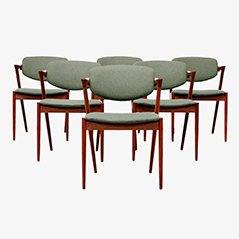We get the lowdown on high-end vintage rehab
Six Lessons in Restoration
Like any true design addict, I daydream about discovering that magical, overlooked piece buried beneath dusty boxes in a random suburban attic. I sweep in—the proverbial knight in shining armor, but with a cooler haircut—and liberate this diamond in the rough, restoring it to its former glory and giving it pride of place in my tastefully decorated home. And all for a price that I can scoff about with friends over cocktails, while enjoying the comfort of my newly acquired, let’s say, Maison Jansen armchairs, softly lit from above by my Paavo Tynell chandelier (both treasures, of course, rescued from a tangled knot of grubby fixtures at a local car-boot sale—thanks to my hawk-eyed discernment). It’s a wonderfully romantic vision. But are such fortuitous finds and restorations realistic, or are these pots of gold at the end of the rainbow of the same veracity as the leprechauns who supposedly put them there? Our team set out to investigate.
First, we approached a number of galleries and dealers, knowing that their experience and networks are second to none. Alas, many declined to comment. We become increasingly aware that restoration is often a subject of the utmost confidentiality, as players jealously protect their artisanal connections and trade secrets. Lesson number one: Approach experts with sensitivity; contacts and advice are valuable commodities in this field.
It was thus with renewed gratitude that we received advice from Dorte Slot, Gallery Director of Copenhagen’s . Slot explains that the key to undertaking successful restoration projects is “to always respect the original condition of the piece.” She adds, “If a piece is in such a bad condition that major parts have to be replaced, the originality of the piece comes into question.” So when is it better to let go of the dream? “It’s always a balance between historical value and current usability,” according to Slot. “Prototypes and extremely rare examples—pieces with noteworthy historical significance or provenance—are certainly the ones you need to consider most carefully.”
Lesson number two: It may be better in some cases to simply embrace the aging and wear, rather than risk compromising the authenticity of the piece, or spend considerably more on restoration than the piece is worth. If, however, you decide to go ahead, what are the most important aspects to consider? Elisabetta Trioschi from Compendio Gallery in Rome wisely notes that “the main piece of advice is to avoid hiding restoration; carry out restoration only in order to maintain the functionality of the item.”
Malte Wrobel, Industrial Designer and Restorer at Frank Landau in Frankfurt sums it up this way: “It is a matter of time and money… If you have a lot of both, then you can do anything you want. If you have deadlines and a budget, everything depends on your skills and experience.” As to the trade-off between an object’s unique aged character and the desire to restore and refresh damaged pieces, Wrobel says, “One of the main reasons not to restore an object is a beautiful patina. It is always worth keeping it and leaving the scratches and cracks where they are.” These minor imperfections in the finish, which have evolved through decades of use, are what make a piece sui generis and as such are utterly irreplaceable as a testament to its history, authenticity, and longevity.
Ike Udechuku from Belgian gallery Ampersand House tells a wonderful story that illustrates how to walk the line between preservation and innovation. He goes into loving detail about the restoration of a pair of vintage, wall-mounted office cabinets by Kai Kristiansen that the gallery repurposed as a stunning bathroom cabinet. “We loved the rosewood and neat tambour doors, but as these are not rare pieces, we felt free to modify one of them,” explains Udechuku. The justification was that the Kristiansen modular shelving system was produced in Denmark in the 1960s and, being modular, was intended by the designer to be a flexible component to be played with according to the user’s needs.
“First, we took the cabinets to an expert ébéniste [cabinet-maker] who restored the surface of the wood and treated it with lacquer to make the pieces suitable for daily use in a bathroom. He even used compressed air to clean the tracks of the tambour doors so they would glide smoothly. Next, we reinforced the wall-mounting system to support a 60-kilo stone sink, which we found in Somerset, England. The sink and taps emerging from the wall are contemporary, but were chosen for their period vibe. The net effect is a simple, floating cabinet that is at once light and monumental.”
Completing the ensemble are two gorgeous and rare Josef Frank mirrors from the 1940s. “The larger mirror has quite pronounced signs of age in the glass, but we would not dream of replacing it, as these marks add to the charm in our view,” Udechuku says. We couldn’t agree more, which brings us to lesson three: The goal should always be to achieve that delicate balance between restoring, repurposing, and maintaining an authentic patina—a task that benefits from a knowledge and experience.
Dansk Møbelkunst confirms that practice makes perfect; Slot admits to “a few disasters, especially in the early years of the gallery. After more than two decades in the business, we now have well-established relationships with the respective craftsmen, each within their field of expertise.” Ampersand House also stresses the importance of expert knowledge and the right contacts: “Restoration starts with finding things that need restoring and knowing what to do about it (including a rough sense of cost)… It takes a team of people with different strengths to do this. We sit at the center of a network of artisans.”
For those without several decades of experience in the restoration business, however, it can be very tough to know where to start when it comes to sourcing the right craftspeople for the job. Malte Wrobel provides us with lesson four, advising: “It is always better to work with a specialist.” Additionally, he notes, you might have to get a bit creative in your thinking. Wrobel tells us about a time he was tasked with restoring a very fragile, metal lampshade that had been rather badly dented and damaged. He says, “I had no idea and no tools to do it properly. I went to a craftsman who normally deals with medieval suits of armor and gave him the shade. He did an awesome job—better than I could have imagined.”
Paul Donzella, from his , breaks it down further: “There are many types of specialists within the restoration field. There are many top restorers who specialize in traditional antiques and do not know their way around 20th-century furniture, for example. This goes for upholsterers as well as wood restorers. But even more specifically, during the postwar period, some wood pieces were originally finished with spray lacquer and some with a hand-applied finish. So if you want to restore a piece and make it historically correct, you have to have wood restorers who can do both. Or have one for each type of need.”
A font of wisdom on the subject, Donzella delivers lesson number five: Research, plan, and be specific. “The most common mistake people make is that they don’t know what it is they need,” he says. “In my experience, many restorers will never say they are not sure how to proceed. They will tell you that they know exactly what to do, and then consequently do a job incorrectly. To even my best and most trusted restorers, I give written instructions for every piece.”
We asked qualified restorers Panter & Kmiotek in Cologne—the young duo’s clients include numerous museums and large private collections in Germany—how a collector can be sure they are dealing with a true professional. Lesson number six: “Collectors on the lookout for academically qualified restorers would do well to start with industry associations, like the Verband der Restauratoren [Association of Restorers] in Germany; these central organizations should be able to provide recommendations for appropriate, serious professionals.” The duo stress that it is important to discern between true restoration—the aim of which is “to stabilize the original material, and to preserve the condition of the piece against further decay, with the minimum of intervention”—and more drastic undertakings, which should rather be called renovation or reconstruction. This difference is significant and echoes the advice of all the dealers we spoke with. For truly unique pieces—the “endangered species” as Ike Udechuku charmingly calls them—a skilled, experienced restorer is essential; one who will work delicately to preserve and repair a piece without compromising its authenticity and history. For other beautiful but less rare pieces, there is more room for experimentation and innovation.
Beware of craftspeople seeming to promise the impossible. “Surface changes, such as discolorations, for example, may only be partially reversible,” explain Panter & Kmiotek. “Scratches in the surface material can be, to a degree, filled in. Decomposition of foam plastics can certainly be slowed through stabilization with appropriate materials, but not completely stopped. Cracks and fissures in the material can be resolved through the careful application of the correct adhesives.” A true professional is likely to explain not only the aspects that they can repair, but also those that can’t—or shouldn’t—be attempted. And if this all sounds very complicated, that’s because it is.
Hence, the question that we repeatedly asked experts and dealers in researching this story: Should inexperienced collectors buy restored or unrestored pieces? Slot recommends leaving it to the experts. “Buy from a respected gallery that you trust to have handled the restoration process in the best way possible. Don’t buy unrestored pieces unless you are prepared to devote the time and energy needed to restore [them] correctly. Even then, consider the fact that the restoration process is complex and that respectable galleries have years of experience with it.” Trioschi advises that “if one purchases a restored item, we suggest to always request photos of the item before the restoration,” to ensure that the authenticity of the piece remains uncompromised.
For a family heirloom that needs some love, it is worth looking for the right professional to do a careful, protective restoration—and it may very well be worth paying an expert for advice on where to start and how to guide the process. If, however, a collector is searching for a special piece to purchase, it is probably prudent to work with an experienced, trusted gallery or dealer, unless the time and financial resources required to patiently work through the restoration process are readily available. And, should someone be lucky enough to really stumble on an unidentified pot of design gold at a flea market or garage sale, by all means seize the chance, but do keep in mind Ike Udechuku’s wise words: “I guess the last word on restoration is about knowing when to leave things as you found them. We do have to strike a balance between reverence for the past and working with things to give them new life.”
-
Text by
-
Gretta Louw
A South-African born Australian currently based in Germany, Gretta is a globetrotting multi-disciplinary artist and language lover. She holds a degree in Psychology, and has seriously avant garde leanings.
-
More to Love
Plant Box by Kai Kristiansen for Salin Mobler, 1960s
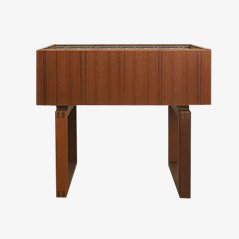
Teak Magazine Rack by Kai Kristiansen for Sika Mobler, 1960s

Teak Desk by Kai Kristiansen for Schou Andersen, 1950s

Wall-Mounted Shelving Unit by Kai Kristiansen for FM Møbler

Model 42 Rosewood Z Chairs by Kai Kristiansen, Set of 6

Oak Dining Chairs by Kai Kristiansen for SVA Møbler, Set of 4

Teak Chairs by Kai Kristiansen for SVA Møbler, Set of 4

Teak Easy Chairs by Kai Kristiansen, 1960s, Set of 4
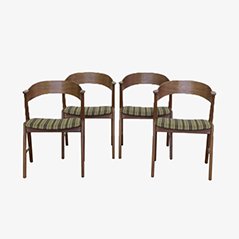
Teak Dining Chairs by Kai Kristiansen, Set of 2
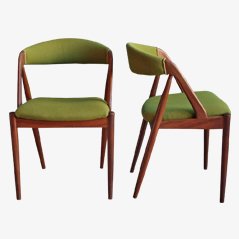
Danish Dining Set by Kai Kristiansen, 1950s
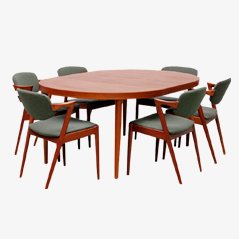
Mid Century Rosewood Chairs by Kai Kristiansen, 1950s, Set of 4

Rosewood Danish Wall Unit by Kai Kristiansen for FM Mobler, 1960s

Scandinavian Oak Chest of Drawers by Kai Kristiansen for Odder Furniture

Mid Century Oak Desk by Kai Kristiansen, 1960s
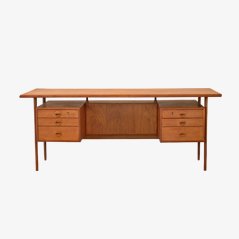
Model 42 Dining Chairs by Kai Kristiansen, 1950s, Set of 6
